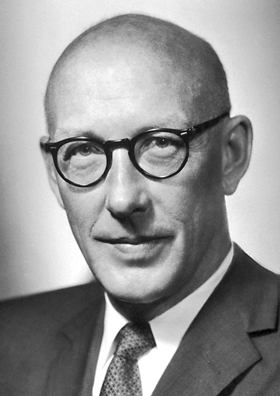Edward Tatum
Edward Lawrie Tatum (December 14, 1909 – November 5, 1975) was an American geneticist.
Edward Tatum | |
|---|---|
 | |
| Born | December 14, 1909 |
| Died | November 5, 1975 (aged 65) |
| Alma mater | University of Chicago University of Wisconsin–Madison |
| Known for | Gene regulation of biochemical events within cells |
| Awards | Nobel Prize in Physiology or Medicine |
| Scientific career | |
| Fields | Genetics |
| Institutions | Stanford University Yale University Rockefeller Institute |
He shared half of the Nobel Prize in Physiology or Medicine in 1958 with George Beadle for showing that genes control individual steps in metabolism. The other half of that year's award went to Joshua Lederberg.
Beadle and Tatum's experiments exposed the bread mold Neurospora crassa to x-rays, causing mutations. They showed the mutations caused changes in specific enzymes involved in metabolic pathways. These experiments, published in 1941, led them to propose a direct link between genes and enzymatic reactions, known as the "one gene, one enzyme" hypothesis.
Tatum went on to study genetics in bacteria. Tatum and his student Lederberg showed that Escherichia coli could share genetic information through recombination.
Ed Tatum was born in Boulder, Colorado. He attended college at the University of Chicago and received his PhD in biochemistry from the University of Wisconsin–Madison in 1934. Starting in 1937, he worked at Stanford University, where he began his collaboration with Beadle. He then moved to Yale University in 1945 where he mentored Lederberg. He returned to Stanford in 1948 and then joined the faculty of Rockefeller Institute in 1957. A heavy cigarette smoker, he died in New York City of heart failure complicated by chronic emphysema.
References
- Nobel Lectures, Physiology or Medicine 1942-1962, Elsevier Publishing Company, Amsterdam, 1964
- Biographical Memoirs: National Academy of Sciences, Volume 59, National Academy Press, 1990